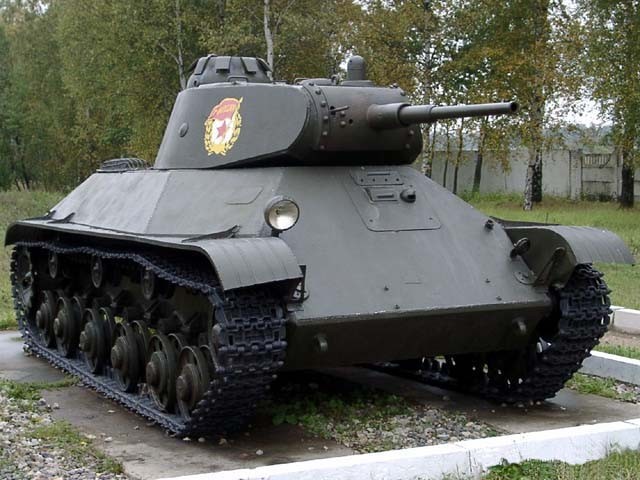
T-50 - Soviet light tank of World War II. developed in 1940 , the plant number 174 in Leningrad under the direction of C.. A. Ginsburg. Also in its creation participated actively and designers. FROM. Bushnev and L. FROM. Troianov.
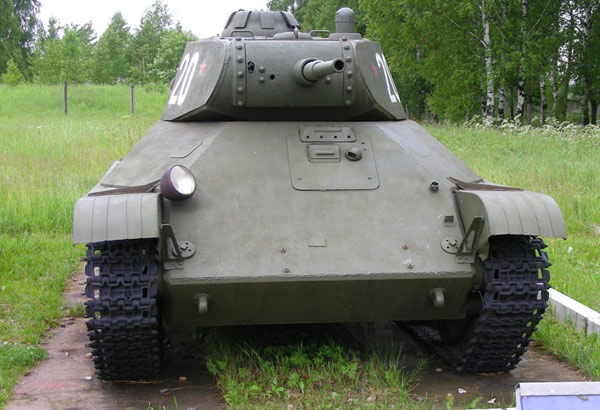
AT 1941 , the T-50 was adopted by the Workers 'and Peasants' Red Army, and the plant number 174 It began its serial production. However, after the start of World War II because of the threat of capture of Leningrad opponent factory number 174 It was first evacuated to Chkalov (Orenburg), then again in Omsk. Due to lack of engines and organizational problems with the deployment of production at the new place of production of T-50 was completed in March 1942 of the year. All were released, according to different sources, 65-75 Lung T-50, who participated in the battles of the Great Patriotic War of 1941-1943 years. One tank was captured by this brand Finnish army and was used until the 1954 of the year. In all of its combat, technical and operational properties of the T-50 is considered one of the world's best tank in its class.
Design
The T-50 was performed according to classical assembly scheme, when sequentially from the nose to the rear of the vehicle placed the driver's compartment, combat and power pack. The hull and turret had significant angles, so their appearance of T-50 was very similar to the average tank T-34 the same layout scheme. In the driving compartment slightly offset from the center toward the left side was the driver's workplace, rest of the crew (aimer, loader and commander) We were in the triple tower. Workplace gunner was situated to the left of the gun, loader - right, commander - in the rear part of the tower to the right of the central longitudinal plane.
Classical layout scheme is defined in the whole set of advantages and disadvantages of the tank under the machine in its class. In particular, rear-transmission compartment, ie driving wheels, beneficial to the reduction of their vulnerability, since the rear extremity of the tank is the least subject to enemy fire. Other advantages of the selected T-arrangement 50 may include a small overall height and weight of the tank (compared to other layout diagrams of other machines), but this was achieved at the cost of minimizing the volume booked in the presence of a crew of four people inevitably led to the ergonomic nature of the problem.
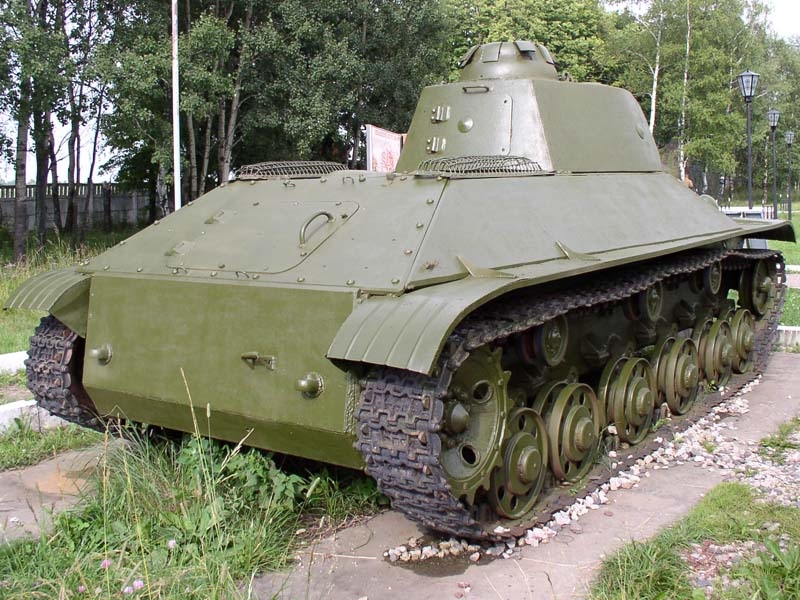
Armor hull and turret
tank armor casing welded from rolled heterogeneous (applied grouting) high hardness armor plate thickness 12, 15, 25, 30 and 37 mm. Armor protection of dyfferentsyrovannaya, bulletproof-protivosnaryadnym. frontal, upper side and stern armor plates have a rational angles 40-50 °, the lower part of the board - vertical. Armor plate body connected exclusively by welding. Workplace of the driver is in front of the tank armored housing with some offset to the left of the central longitudinal plane of the machine. Luc landing-landing of the driver located on the frontal armor plate was provided with a balancing mechanism to facilitate opening. The presence of the driver's hatch weakened resistance to the upper front part of shell impacts. Plates on the engine and transmission compartments are removable for ease of engine and transmission service. It was well designed cooling system, when air is drawn through the meshes protected and armored shutters rectangular opening in the roof of the engine compartment, blew components and assemblies therein and ejected through the output slit over the tracks. There also direct the exhaust gases of the diesel engine. The housing also has a number of hatches, hatches and technological openings for ventilation of habitable space of the tank, drain fuel and oil, access to fuel tanks, other nodes and aggregates machines. A number of these openings caps defended armor, flaps and covers.
Welded tower complex geometric shapes board had a thickness 37 mm, which are arranged at an inclination angle of 20 °. The front part of the tower was protected cylindrical mantle result thickness 37 mm, which were embrasures for mounting guns, machine guns and sights. The roof of the tower mounted fixed commander's cupola with eight observation devices triplex hinged flap flag for signaling. Landing-landing commander, gunner and charging was performed through two front hatch commander's cupola. In the rear plate of the tower also has a hatch for loading the ammunition and ejection of spent cartridges, through the machine commander could leave the tank in an emergency. The tower was set for a ball bearing was fixed grippers and avoid stalling under strong roll or roll-over of the tank.
weaponry
The main arms of T-50 was rifled semiautomatic 45 mm tank gun arr. 1934 (1938) g. (20-TO) with vertical wedge gate. The gun was mounted on the journals in the longitudinal plane of symmetry of the tower, mated with him two 7.62-mm machine gun DT, which could easily be removed from the structure of the plant and used outside of the tank. Structures installation had elevation angles range from -7 ° to + 25 ° and circular firing horizontally. The length of the gun barrel 20 K was 46 calibres, range of direct fire reached 3,6 km, the maximum possible - 4,8 km. Swivel and lifting mechanisms aiming Structures installation, as well as the descent equipped with manual drive.
Ammunition gun was 150 shots unitary loading (rounds). When firing armor-piercing projectiles extraction of spent cartridges carried out automatically, and for firing projectiles with fragmentation due to the lower barrel recoil length, due to the low initial velocity of the projectile fragmentation, semi-automatic not working, and the commander had to open the gate and manually remove the spent case. Theoretical rate instruments was 12 rounds per minute, but because of the need for manual extraction of spent cartridges from the fragmentation of the projectile fire pace in practice was slightly lower, 4-7 rounds per minute.
Paired DT machine guns had ammunition in 4032 chuck (64 disk), also the crew was provided with a sub-machine gun with a PPD 750 cartridges and 24 hand grenades F-1. In some cases, this armament was added to the gun firing flares.
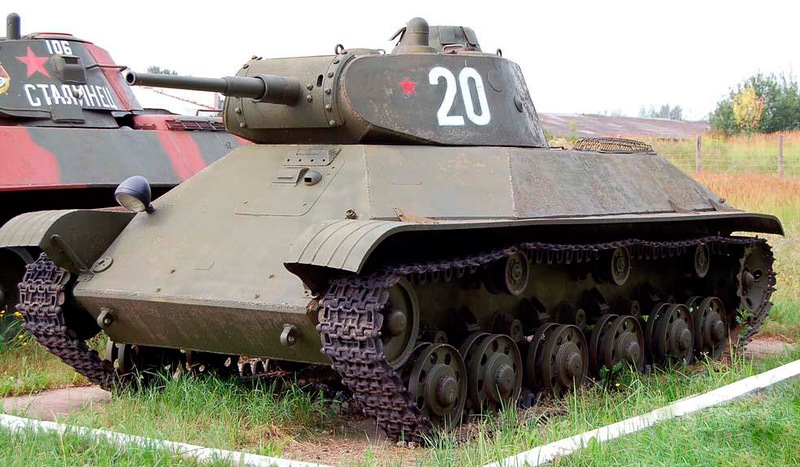
Engine
T-50 was equipped with a four-stroke in-line 6-cylinder diesel engine with liquid cooling capacity of the B-4 300 l. from. Starting the engine starter inertia ensured by hand or by an electric motor, It was also provided and the start of the compressed air from the air reservoirs within the machine. T-50 has a dense layout, in which the main fuel tank capacity 350 l housed in the battle, and engine-transmission compartment. This supply of fuel was enough for 344 km running on the highway. To ensure the supply of fuel from the tank to the diesel fuel feed pump in the tank was produced by overpressure via a special manual air pump.
Transmission
The T-50 was equipped with a manual transmission, which included:
– dual-main clutch "steel Ferodo" dry friction spring damper unit;
– four-stage gearbox (4 transmission and forward 1 ago);
– two friction clutches with friction "steel on steel" and belt brakes with pads Ferodo;
– Two on-board DIP gear.
All transmission control actuators - mechanical. Stopping band brakes had a special clamp for securing them in the locked state. Compared with the transmission medium and heavy tanks development, 1939-1941. Transmission T-50 was considered quite reliable.
Chassis
Chassis tank T-50 was a new development for the Soviet mass-produced light tanks (a similar solution was applied to other classes of machines - small tanks T-40 and heavy KB-1). Suspension machines - individual torsion for each of the 6 gable of track rollers on each side of small diameter. Next to each track roller welded to the hull of travel stops suspension balancers. Driving wheels with removable gear rings lantern meshing located behind, and sloths - the front. The upper branch melkozvenchatye caterpillars open metallic hinge supported by three small support rollers on each side. Odnogrebnovye tracks Track Width 360 mm cast steel of Hadfield.
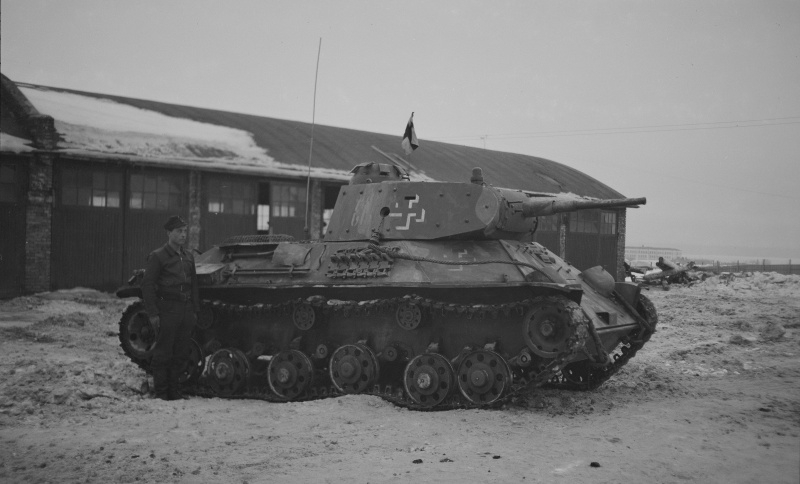
Finnish tanker near captured Soviet tank T-50 in repair hangar Petrozavodsk
electrics
Wiring in the T-50 was a single wire, the second wire served hull of the machine. power sources (operating voltage 12 AT) were DPF-500T generator relay-regulator RRB-GT-500 power 0,5 kW battery stamps 3-STE-126 total capacity 126 Ah. electrical consumers included:
– exterior and interior car lighting, scales backlight unit sighting;
– outer beep;
– means of communication - radio, tank intercom, and unilateral and warning from the commander to the mechanic-driver;
– electrical motor group - motor inertia starter, etc.. P.
Sights and observation devices
The structure of the unit 20-K and DT machine guns gun was equipped with a telescopic sight TOC, a second tank also equipped with the periscopic sight of PT-1. The driver was equipped with an inspection device laminated on the cover of the access hatch, on the part of the machines was supplemented with two more similar devices in the cheeks nose of armored housing. In a tranquil setting on the march hatch opens, and a driver to directly observe the surroundings. Gunner and loader had their periscopes and vision devices in the sides of the tower, triplex, a Commander T-50 led through the circular observation commander's cupola with eight observation device. Visibility out of the car than any other Soviet tank at the time was regarded as a great.
Means of communication
The T-50 equipped with radio KRSTB, internal intercom TPU-3 3 user and warning lights for the interior one-way communication from the commander to the mechanic-driver.
KRSTB radio station was built on the transceiver circuit, and from a technical point of view, it was a tube shortwave radio, operating in the frequency range of 3,75 to 6 MHz (respectively wavelengths from 80 to 50 m). Parked in a telephone communication range (voice, Amplitude modulation of the carrier) mode with no interference reached 16 km, the move is somewhat decreased. Most of the communication range can be obtained in telegraph mode, when the information is transmitted in Morse code telegraph key, or other discrete coding system. Subsequently, the radio KRSTB served as a basis for further development of the 10-P Series radios.
Tank intercom TPU-3 allowed to negotiate between the tank crew members, even in very noisy environment and the headset connect the headset (headphones and laringophones) to the radio for external communication.
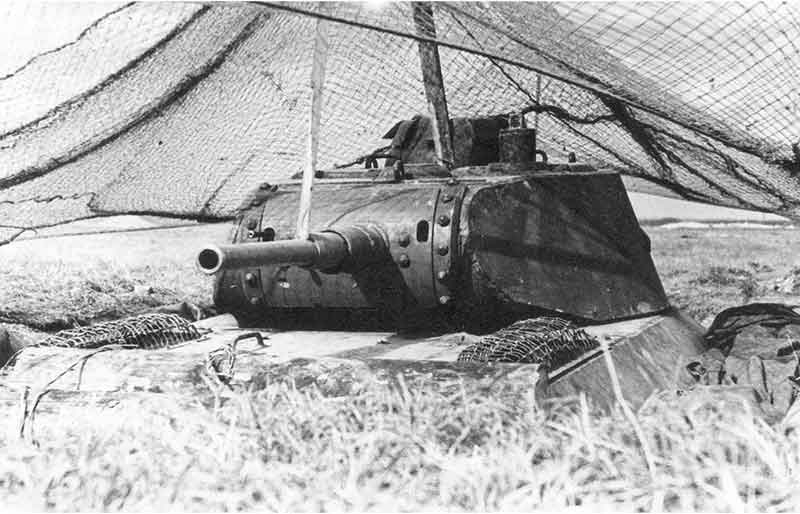
The T-50 caponier
modifications
prototypes
– T-126(SP), an early version of the tank with the NPP protivosnaryadnym booking. Built two cars with thick armor 45 and 37 mm, respectively,.
– T-50, a prototype of the Kirov factory. Adopted by the Red Army in the armament factory sample number 174 externally differed altered body shape. The car was built in a single copy, and participated in the battles of Leningrad.
serial
Light tank T-50 officially issued in a single burst modification, however, it can be divided into two subtypes:
– T-50 basic model;
– T-50 is simplified. From the basic model this kind of different 40-mm homogeneous armor instead of 37 mm cemented, cast welded turret instead, and part of the machine has been released without the commander's cupola.
There are also allegations, that in the course of military operation serial T-50 retrofit in the field additional armor shields. Captured by the Finnish Army T-50 also received additional armor. Experienced and production of combat and special vehicles (HEALTHY, MAT, BTR, BREM, tractors and others.) based on light tank T-50 were not issued.
projects
– T-127, the tank body has been considerably narrowed and assembled from sheet rolled thick armor 30-45 mm, allowing to downsize 12,5 tonnes. Also it uses half the amount of torsion bars, than T-126(SP), and only appeared engine D-744.
– T-50-2. Immediately before the beginning of the Great Patriotic War is also reviewing its installation in the T-50 is more powerful 57- or 76 mm cannons, as well as its transformation into anti-aircraft tank by installing a new tower with 25-mm automatic anti-aircraft gun mod. 1940 g. (T-50-3). In connection with the outbreak of war all the work on these projects have been stopped, and went beyond the stage of rough sketches and drafts.
– "SU-T-50" - a project on bases SAU T-50 by using 76 mm cannon obr.1927 / 31 g. Because of the outbreak of the war the project was closed.
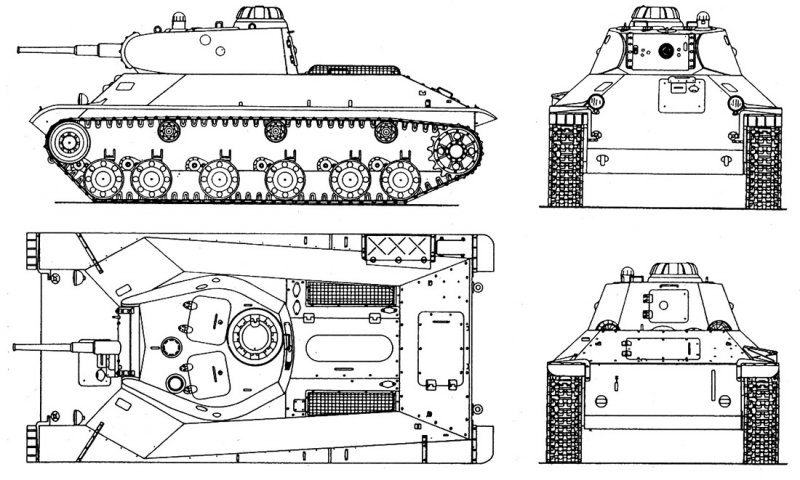
Drawings tank T-50
Organizational structure
In view of the issue's small, chaos to the confusion after the war and repeated changes in the states of the Soviet tank units in the second half 1941 , the single version of the organizational structure with the guidance of an approved amount of T-50 does not exist. Issued T-50 were transferred to the newly formed or reloadable military units in small batches on completion of their construction, replacing disposed down light tanks BT types and T-26. Therefore, in the surviving reports about the presence of the material of the T-50 is featured as part of units with a very diverse fleet of tank. In particular, as of 11 August 1941 , the 1st Panzer Division of the 1st Mechanized Corps consisted in its composition 14 T-28, 22 KV various modifications, 48 BT various modifications, 12 T-26 and 7 T-50. Such a state of affairs in the north-west direction, and especially on the Leningrad front was maintained long enough, eg, 220-Tank Brigade 55th Army as of 27 September 1942 years had 8 T-28, 18 HF various modifications, 20 T-34, 17 T-26 4 T-50.
combat application
Information about combat use of T-50 is a fragmentary, as the front-line archive documents contain little information about this matter. Also, due to the small scale of release is unknown, and direct feedback on the tank soldiers who fought on it. However, in his letter to the staff of the plant number 174, dated July 1941 of the year, Chief of the Red Army I GBTU. n. Fedorenko evaluation gave the following T-50:
– Your new tank is extremely needed at the front. he has fail-safe, malozameten, well booked, It has excellent permeability and mobility. Red Army command asks you to make every effort for the full production of tanks crossing the front ...
Most of the tanks was issued in the north-western sector of the front - near the factory in Leningrad. At the Leningrad Front fought 37 production vehicles and one of Kirov plant tank prototype. for example, 10 tanks of this type was in the 1st Armored Division 1st Mechanized Corps (of them to 1 October 1941 year was lost 6 machines), At least three - in the 2nd division of the national militia, 10 tanks - a 84th separate tank battalion, etc.. P. Several T-50 there was a part of the 7th Army, He participated in battles on the Karelian Isthmus with the Finnish Army. In a small number of T-50 continued to fight on the Leningrad front and in the following years, last car was lost in September 1943 of the year. The tower T-50 used in the construction of fortifications near Leningrad.
It is also known to use the T-50, near Moscow - in 1941 , as part of the 150th Armored Brigade of the Bryansk Front had 8 T-50, another a tank joined the 22th Tank Brigade of the Western Front. Yet 2 tank with LBTKUKS were evacuated to Magnitogorsk.
27 T-50, as the Leningrad, and Chkalov release, It became part of the 488-th separate tank battalion, thrown in front Transcaucasian. In October 1942 - January 1943 the battalion was actively involved in the fighting in the North Caucasus. TO 1 February 1943 serviceable materiel, the battalion had already left and was soon to re-form.
One T-50 was captured by Finnish troops and was used until the end of the war (with enhanced reservation). After the war, the tank was operated in the Finnish army to 1954 of the year.
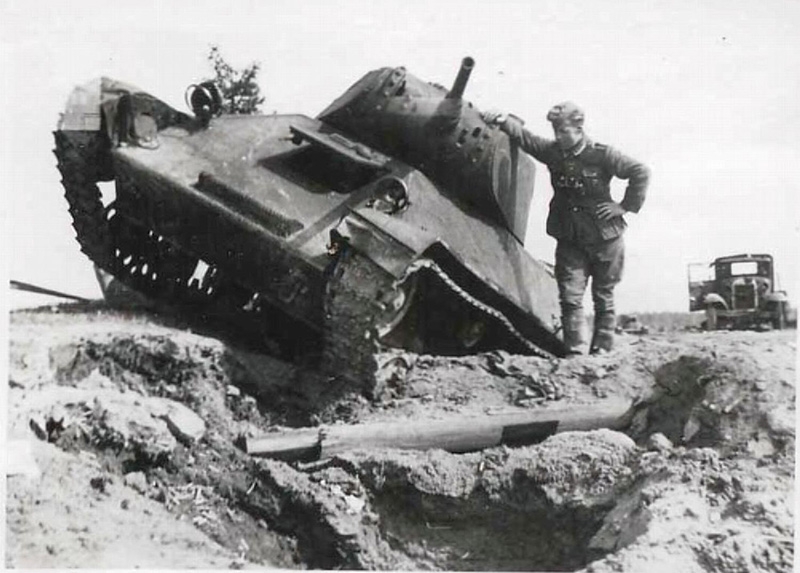
Evaluation of the project
Among the pre-war Soviet tanks T-50 takes a few isolated place. This war machine was very largely devoid of common troubles for the time of Soviet tank: low grade suspension and powertrain, as well as the poor review of the battlefield. Soviet designers have been significant advances in mobility - power density of T-50 was about values 20 l. p. / m, and the ratio L / B (portion length ratio caterpillars, in contact with the ground to the tank width) equal 1,17. for comparison, in a medium tank T-34, these parameters were 18,3 l. p. / m and 1,5 respectively. As a result, "fifties" was very agile and dynamic. The security of T-50 was also evaluated by specialists RKKA very high: tank book securely protect it from fire most common in 1940-1941. German 37-mm anti-tank guns and. With a large angle relative to the normal meeting armor T-50 also had a good chance to survive against the 50-mm shells and more powerful anti-tank guns. Also of note, that due to carburization armor T-50, snaryadostoykost considered its equivalent characteristic similar thicker armor medium tank T-34. High power density potentially can significantly enhance Car, several sacrificing dynamic performance.
Problems with the ergonomics of the crew compartment at the T-50 did not have a particularly acute, since the machine was created with the known characteristics of an eye to a very worthy in this respect German PzKpfw III. Despite occurring allegations of cramped tower T-50, it quietly placed without problems three people. Tower T-50 had hatches for landing on the landing-jobs gunner and loader. Commander of the machine in an emergency leaving the tank through a hatch in the turret.
The main weakness of the T-50 was its armament. On 1941 year 45-mm gun 20-K could no longer be considered sufficient for power against the enemy armored vehicles, and against unarmored targets or field fortifications. Heterogeneous 50-mm armor was already beyond the scope of regular armor-piercing projectile BR-240 at all distances, and declared 40 mm armor penetration corresponded manufactured strictly according to the approved projectile technology. With the latter in the USSR (especially after the outbreak of war, when the release of ammunition were connected to mainstream civilian enterprises) were very great difficulties, the consequence of which was the fact, that the 45-mm projectile BR-240 with very great difficulty punching board 32 mm cemented armor of German medium tanks. This problem was solved Gartz design office to an end 1941 of the year, when his team has developed a new armor-piercing 45 mm projectile BR-240SP. Only after the adoption of the BR-240SP on arms and began to mass production of 45-mm anti-tank guns and tank armor found, even slightly higher than for the stated regular BR-240. This weakness of the T-50 was realized in the leadership at the stage of its design, The design bureau. D. Grabina T-50 developed a new 57-mm tank gun, that potential output capability of the machine to the next level. However, a problem with projectiles were not limited to one 45-mm caliber, while there were difficulties with the 57-mm, and 76mm ammunition, Therefore, disclosure of such capacity is in question. The beginning of the war finally put an end to the issue of the development of 57-mm guns for T-50, since before the design bureau in. D. Grabin were supplied more important tasks.
Eventually, despite all the cost and benefits of ergonomic T-50, more promising in theory, and in practice proved Soviet tank medium tank T-34 with an equivalent result "fifties" armor protection and much more powerful weapons. Nevertheless, lower cost in comparison with the T-34 and absolute superiority in all parameters over the most massive prewar Red Army tanks T-26 and BT-7 made T-50 tank is very attractive in the eyes of Soviet military specialists even in the 1942-1943. Although the objective reasons noted above did not allow him to resume production, namely the T-50 is the benchmark for domestic mass of light tanks 1941-1943. Known constructor H. A. ASTROFF, developing lung weight range of T-60 - T-70 on the basis of small floating tank T-40, in its end I was able to achieve close to T-50 performance in the T-80. At approximately equivalent frontal protection and ergonomics of T-80 was armed identical with T-50 cannon, greatly exceeded the T-50 weapon in elevation and manufacturability, but so is much inferior to the on-board reservations and mobility. Interesting, that the T-80 suffered the same fate, as the T-50 - low-volume (about 80 PC.) release and removal from production.
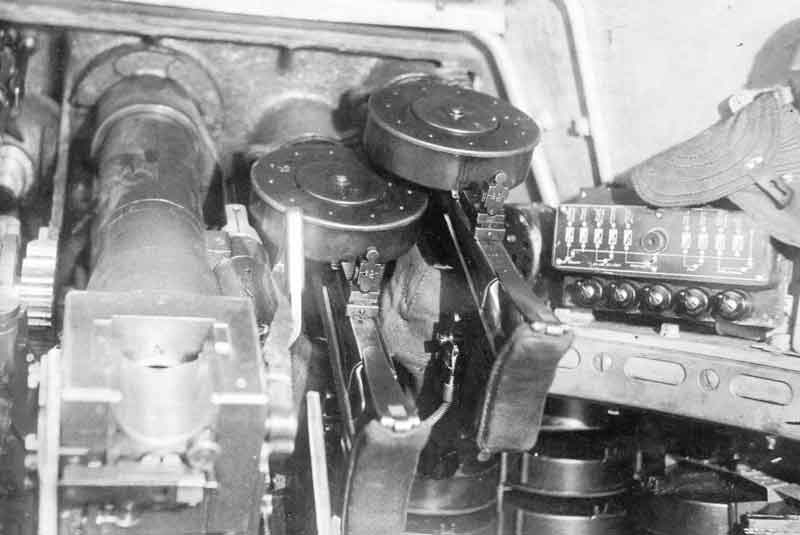
Tank gun and coaxial machine gun tank T-50
foreign counterparts
According to mainstream T-50 hits in a row with the Italian tank Fiat M14 / 41, Czechoslovakia TNHP-S (LT-38) "Prague" (better known as PzKpfw 38(t)), British "Valentine", French "Hotchkiss» H 39 and American M3 (M5) "Stuart". According to its characteristics the T-50 looks good: not inferior or superior to the security of all these machines with the exception of "Valentine"; his arms also has its advantages and disadvantages in comparison with foreign machines. Caliber armor-piercing projectile action 45mm cannon somewhat inferior to similar parameter 37mm Czechoslovak and American munitions, 40-mm English; but it was much stronger than the effect of the French 37 mm and 47-mm armor-piercing projectiles Italian. It is worth noting, that 1942 , 45-mm Soviet tank gun began to be equipped with discarding sabot projectile (although in a small proportion to the amount caliber armor piercing ammunition), allowing at close range pierce armor thickness up to 80 mm. Except for the almost equivalent of fragmentation 47-mm tank gun Italian, 45-mm gun T-50 was superior to all the 37 mm cannons, and 40 mm (and initially even higher 57-mm) gun "Valentine" does not staffed with high-explosive ammunition. Comparison of the T-50 with German PzKpfw III is illegal from the technical point of view, because the last car to 1941 I was finally moved from the category of "mild-to-medium" in complete medium tanks weighing about 19 t, but it may be appropriate in the light of similar views in their application of the doctrine. German tank had tangible benefits in the security of (to 60 mm hardened armor in the frontal part and 32 mm on the sides) and in arms - even 42 Internal cylindrical 50 mm cannon exceed 20 K in muzzle energy and specific impulse caliber armor-piercing projectile fragmentation and effectiveness.
prerequisites
In the second half of the 1930s, the foundation of the Soviet tank forces was light tank T-26, which was the most massive example of armored vehicles in the USSR the pre-war period. This war machine direct support of infantry (NPP) on the battlefield in the early 1930s it has been the undisputed leader in its class, but the rapid development of foreign tanks and the appearance of almost all armies of the world inexpensive mass anti-tank artillery changed the situation unfavorable for the USSR side. One of the first signals of the T-26 on the need for substantial modernization was the report in 1936 by famous designers with. A. Ginzburg chief of the Main Armored Directorate of the Red Army (GABTU) the emergence of new foreign cars, exceeding T-26 on a number of parameters. In particular, It recommended to pay attention to the French tanks "Renault» R 35 and "Forge e-Chantier» FCM 36 and Czechoslovakian "Škoda» Š-IIa, in the construction of which has already been implemented advanced technical solutions: welding and casting thick armor parts, Suspension high performance. However, the report was rejected by the M. n. Tukhachevsky, who served at the time as deputy of the USSR People's Commissar of Defense for Armaments.
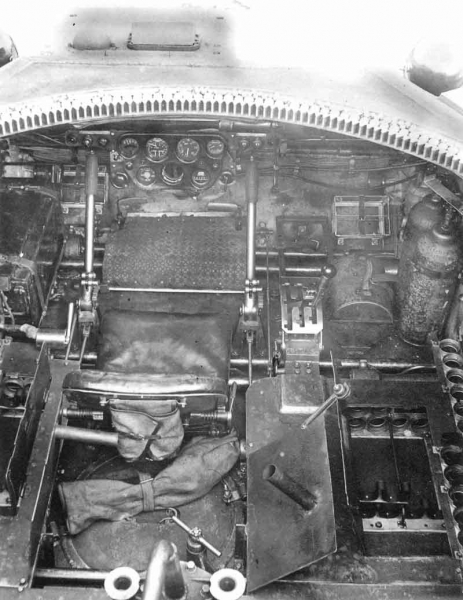
Branch control tank T-50
after displacement, arrest and execution of Tukhachevsky 1937 year, the army leadership and the defense industry have occurred over major personnel changes. Already at the beginning 1938 , Soviet military realized, that the T-26 began to rapidly become obsolete, With that, it was noted. A. Ginzburg still one and a half years earlier. TO 1938 , the T-26, still surpass foreign cars on arms, I began to give way to them by other parameters. Primarily marked weakness reservation and insufficient mobility of the tank in connection with the small motor capacity and congestion suspension. Furthermore, trends in world tank building development at that time were as follows, that in the very near future, the T-26 would lose their advantage and the last - in arms, that is the beginning of the 1940s to become completely obsolete. However, immediately proceed to design a fundamentally new tank support infantry Soviet leadership did not dare, considering, that the design of the T-26 has a more serious possibilities for its modernization. Nevertheless, plant design office number 185 under the direction of C.. A. Ginzburg received permission to manufacture the prototype with reinforced armor and suspension. Called T-111 this prototype was built in April 1938 of the year, tested and generally received good reviews, but his weight, he moved into the category of medium tanks, it is the first attempt to create a light tank with protivosnaryadnym book to replace the T-26 failed.
Experienced upgraded T-26
Upon completion of the test T-111, using the thus obtained experience, at the end 1938 From year. A. Ginzburg and members of his Bureau began work on the project of the T-26M with reinforced suspension according to the type of the Czechoslovak tank Š-IIa, who at the time was tested in the USSR (Soviet government then considered the question of its purchase). However, to satisfy both parties failed to reach an agreement, so with the approval of the People's Commissar of Defense for one night standing in the hangar of the tank he was secretly examined and measurements of a group of Soviet engineers. AT 1939 year T-26M was submitted for testing, which confirmed the effectiveness and reliability of the new suspension.
More during the work on T-26M plant № 185 commissioned GABTU started the development of the T-26-5, treated as capital upgrading T-26. In addition to the suspension of the "Skoda" in it was planned to use forced up 130 l. from. and motor 20 mm cemented armor hull sides. TO 1940 year this tank was ready for testing (except for the high-revving engine).
Soviet-Finnish war of 1939-1940. It identified the need for a significant strengthening of the reservation of all types of tanks. Therefore GABTU make demands to strengthen the side armor of the tank to 30 mm hardened armor or to 40 gomogennoy. At the same time in 1940 by OKB-2 plant number 174 Glavspetsmasha by the People's Commissariat of Medium Machine Building gets the task of designing a new tank with armor 40 mm, torsion bar suspension, In the diesel engine 3 and machine guns DS. In fact, from that moment begins the design of T-50. After combining plants № 185 and 174 Project T-26-5 became known as "126-1", and the project on the instructions Glavspetsmasha - "126-2". AT 1940 year "126-1" was submitted for testing, but was not taken into service, as to create suitable for installation in the engine compartment T-26 engine required power failed. it became evident, that the T-26 completely obsolete, and attempts to modernize are not serious prospects. Project work focused on the new tank. "126-2" project in the metal is not implemented, and both the development undergone serious criticism on the part of the customer, who insisted on the unification of a number of components of the future tank support infantry and tank A-32 (prototype future T34), as well as maintaining weight machines in the category of light tanks. As a result, hot discussions between the KB, GABTU and NGOs tactical and technical requirements (TTT) the new tank has undergone substantial changes.
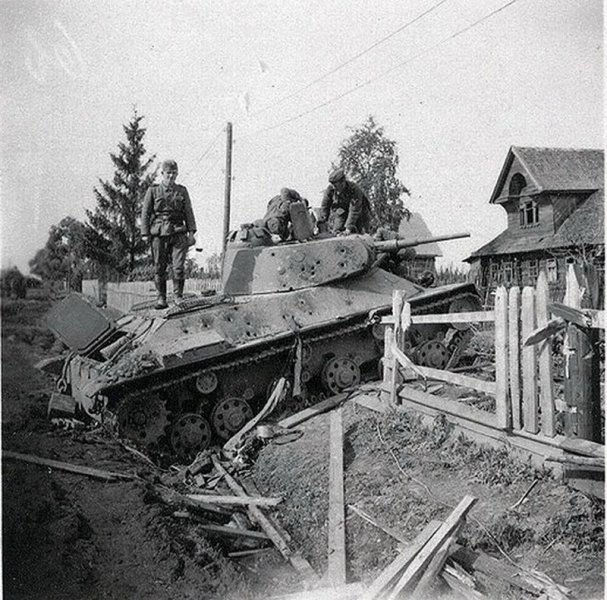
The T-50 of 86-th padded sel near Pogi – Novolisino. 4 September 1941 of the year.
In particular, 29 April 1940 the People's Commissar of Defense said on TTT "SP tank" (project 126). Anticipated creation of tank weighing no more 13 tonnes, crewed 4 man, 45-mm gun and 2 machine guns DT (paired and exchange rate), thick armor 45 mm and a diesel engine B-3. By August 1940 We have been prepared to test two tanks T-126-2: one with armor 45 mm and a mass of 17 t, the second - with the armor in 55 mm and a mass of 18,3 t. Tank was very tight because of the desire to meet the predetermined limit weight - developers save on every cubic centimeter of volume booked. His role is also played by a certain "voluntarism" of Marshal Kliment Voroshilov, which preferred classic layout tanks other possible schemes. Although generally classical arrangement does have a number of advantages, but with reference to the light tanks of small dimensions other layout solutions and can give the best result. 31 August 1940 the first sample of the T-126(SP) He proceeded to factory tests.
Effect PzKpfw III
During the Polish campaign 1939 the Red Army was able to seize the damaged and abandoned soldiers of the Wehrmacht German tank PzKpfw III, and during the subsequent military-technical cooperation with the Third Reich had reached an agreement to buy another tank PzKpfw III Ausf F. Both German cars were subjected to scrutiny, including sea trials and firing of 45-mm anti-tank gun mod. 1937 g. The test results have produced a great impression on the Soviet military leadership - on the level of their mobility, of security and convenience of the crew PzKpfw III Ausf F was recognized in the Soviet Union as the best foreign tank in its class. It was given the task to finalize the draft of the new light tank, taking into account the information, obtained in the study of German tank:
... It should not delay a minute to continue work on the tank "126" in order to bring all of its characteristics to the level of the German machine (or exceed it)…
- A letter from the Chief GBTU I. n. Fedorenko K. E. Voroshilov 13 / IX / 1940
final decision
Autumn 1940 year was a turning point in many areas, related to the development of armored vehicles in the USSR, including in the fate of light tank NPP. The country's top leadership of the army and the experience of fleeting campaign Wehrmacht in France has made a bet on large mechanized connections and announced the formation 30 mechanized corps. But their equipment did not have enough material part, and th, that was available, in many cases it proved to be incomplete or badly worn, and therefore in need of urgent replacement. Tests German PzKpfw III also pushed the idea GBTU, that Soviet troops are in need of a similar "one tank", which should not be inferior to the mobility BT and be securely protected from the fire 37-mm anti-tank guns at all ranges. In this role claimed by two cars - Kharkov T-34 prototypes and Leningrad T-126(SP). Since the 1940 , the value of the T-34 was very high, It is not suitable for the role of the mass in the tank of the Red Army. Although T-126(SP) to 20 September 1940 I have already completely passed all necessary tests, he also was rejected GBTU for the same reason. To bring the value to an acceptable value, It was demanded to reduce the weight of the tank 14 t, what could be done only at the cost of weakening booking. In this way, new "one tank", initially grew out "infantry" T-26, had to replace not only the, but also high-speed BT.
For the right to obtain an order for the construction and production of the tank design teams competed factory number 174 them. TO. E. Voroshilov, Kirov factory and graduates of the Military Academy of mechanization and motorisation them. Stalin. Group Alumni Academy led already has considerable experience in the construction of light tanks H. A. ASTROFF, but their project, Strongly resembles PzKpfw III, It was rejected because of the need to rework the engine B-4. December 1940 , the rest of the developers have successfully defended their projects and received permission for the construction of experimental machines. plant design office number 174 presented experimental tank "Object 135" design A. FROM. Troyanova and C. A. Ginsburg, and CSC-2 Kirov plant constructed similar machine with high performance engine cooling system horseshoe, and in the future it promised and more production for her whole-piece hulls. On the comparative tests in February - March 1941 year, both experienced tank showed similar results, and the question of adopting a hesitant for reasons of manufacturability of future serial production. Here otdavalos Preferences prototype plant number 174, and the end of February, without waiting for the completion of the final test, he was adopted by the Red Army under the T-50.
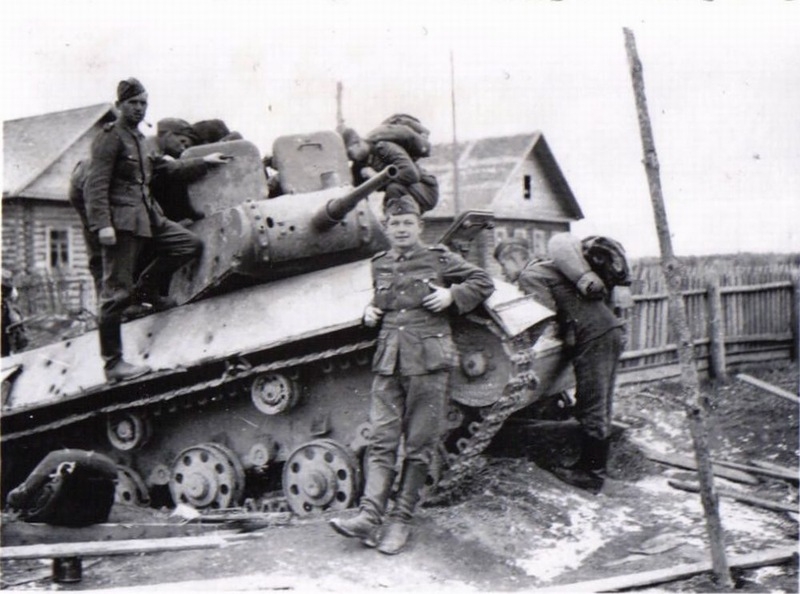
Production
Shortly before the outbreak of World War II, 12 April 1941 of the year, The USSR Council of People's Commissars adopted a decree on the beginning of pre-production of T-50 1 July 1941 , the plant number 174 Temporary technical process. supposed to 1 October release 25 tanks, and in the IV quarter of the same year to complete work on the launch of the first stage of the assembly line for mass-produced cars. Its output is the planned capacity provided for in the beginning 1942 of the year. The estimated need for T-50 only to make up for the shortage in the BT-7 for mechanized housings on 1941 year was 550 machines, not to mention other parts and connections, as the tank, and infantry troops of the Red Army.
As of the day of the Great Patriotic War, 22 June 1941 of the year, T-50 are not commercially produced, and his troops did not receive. Nevertheless, the first production machines were shipped to the army in July 1941 of the year. However, the course of the fighting took extremely unfavorable for the USSR in nature in the north-west, in July 1941 year there was a threat of possible blockade of Leningrad, factory number 174 suffered nalёtov lyuftvaffe, became irregular supply of components from subcontractors - a number of companies tankostroitelnoy industry was already in evacuation. By August, the situation has deteriorated so, that the order was given to the evacuation of the plant number 174 in g. Chkalov (this name while wearing Orenburg). During the time from the start of production until the departure of the evacuation was issued 50 T-50. Also on the issue of the mobilization plan, the T-50 was supposed to start the plant number 37, However, this turned out to be quite difficult tank to the enterprise can not afford, and it continued to produce light tanks T-40, and then transferred to the production of T-60.
At the end 1941 , the tank has undergone a significant number of simplifications, facilitate the production. By January 1942 year were ready working drawings on the body of homogeneous armor thickness 40 mm, optimized for semi-automatic welding, drawings cast on a tower having a wall thickness 50 mm. Production planned for 10 February, the launch of a series in March. Subcontractors performed the plant number 180, which was not engaged in casting. As of 30 December 1941 year, no case or tower he did. Towers on the issue of tanks December-March were put in a reserve, triple. According to 30 December 1941 of the year, factory number 174 there 36 buildings, 31 tower and 26 engines. This amount includes 10 collected in December T-50. December 1941 , the commander's cupola was excluded due to problems with the supply of observation instruments. At the new location the plant number 174 released more 15 tanks. Subsequently, the plant number 174 It was again evacuated to Omsk. 13 October 1941 the State Defense Committee (LOQ) I decided to build two plants in Barnaul: one for the production of T-50 and the second tank - for the manufacture of tanks for diesel B-4. Despite all the difficulties of wartime, at the beginning of July 1942 the plant number 174 Omsk was close to the introduction into the conveyor system for the production of T-50, We have walked its commissioning.
However, in July 1942 year of production of T-50 decided to temporarily (as it turned out, forever) refuse. Plants in Omsk and Barnaul have been reoriented to the production of T-34 and their engines. This decision is explained by the following reasons:
– in connection with the evacuation of the Stalingrad Tractor Factory originated failure to release the T-34 in a very difficult time in the summer offensive of the Wehrmacht 1942 year. In this situation, an increase in output has spent the T-34 was considered more important;
– T-50 has not been finally resolved the issue with the production of engines: Yaroslavl Automobile Plant, which was supposed to produce them, at 1942 It was burned down after the air attack, Barnaul engine production had yet to establish. Evacuated backlog of about 200 The engine has been illegally seized by the director of the Chelyabinsk Kirov Plant and. M. Salzmann was it used for the production of engines KV tanks;
– power 45 mm tank gun 20-K, which arming T-50, It was inadequate by the standards 1942 of the year;
– a number of enterprises have been widely deployed production of light tanks T-70, equivalent T-50 armament. Although T-70 greatly lost T-50 sides armor protection, the allocation of responsibilities between the members of the crew and somewhat inferior in mobility, He was also much cheaper and smarter in production. Also under the Lend-Lease tanks began to arrive successful "Valentine", close to that of a T-50.
Nevertheless, and after 1942 years attempts have been made to restore the production of T-50, because the army needed in the modern lightweight tank, and the T-70 and "Valentine" is only partially satisfied the requirements, that combat experience put forward in relation to this class of combat vehicles. However, for several reasons (including the inability to establish a production of some components) at 1943 year could not do. later, when it became clear, that PzKpfw III, T-50 equivalent in the opinion of Soviet military specialists, no longer has a main tank of the Wehrmacht, the question of the production of "fifties" was closed permanently.
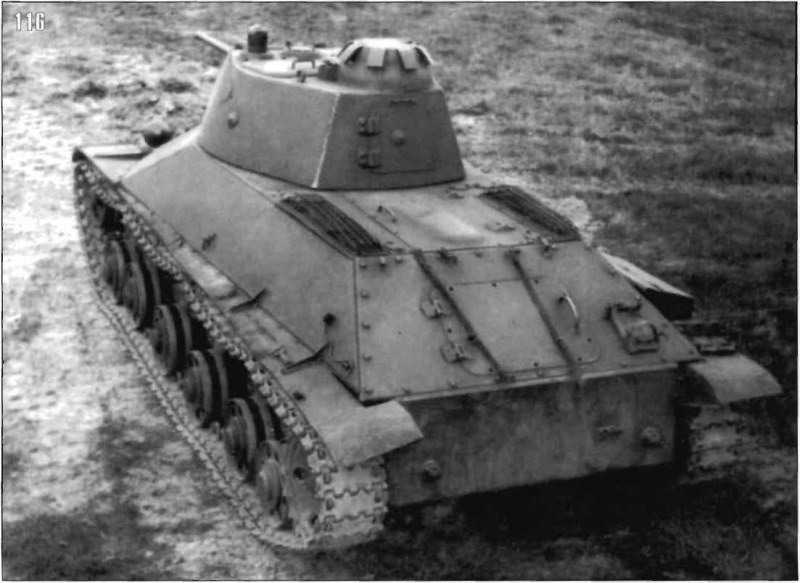
The performance characteristics of the tank T-50
Crew, pers.: 4
developer: OKMO
The layout: classical
The number of issued, PC.: 75 series of tanks and two prototypes
Weight of tank T-50
– 13,8 tonnes
Dimensions of the T-50
– body Length, mm: 5200
– housing width, mm: 2470
– Height, mm: 2165
– Clearance, mm: 350
Armor tank T-50
– Type broni: cemented steel, high hardness
– housing forehead (top), mm / city.: 37/50°
– housing forehead (through), mm / city.: 45/225°
– body board (top), mm / city.: 37/40°
– body board (through), mm / city.: 37/90°
– housing feed (top), mm / city.: 25/63°
– housing feed (through), mm / city.: 37/10°
– Bottom, mm: 12—15
– corps roof, mm: 15
– tower forehead, mm / city.: 37/65—85°
– gun mantlet, mm / city.: 37
– board towers, mm / city.: 37/20°
– tower feed, mm / city.: 15/15°
Arming of the T-50
– Caliber guns and stamp: 45-mm 20-K
– barrel length, calibres: 46
– gun ammunition: 150
– sights: CBT and PT-1
– Shotgun: 2 × 7,62-mm DT
Engine tank T-50
– engine's type: In liquid-cooled diesel-4
– Engine power, l. from.: 300
The rate of tank T-50
– Road speed, kmh: 60
– Speed over rough terrain, kmh: 40
– Cruising on the highway, km: 344
– Cruising cross country, km: 280
– power density, l. p. / m: 21,7
– suspension type: torsionnaya
– Unit ground pressure, kg / cm²: 0,56
– Gradeability, city.: 40°
– to overcome the wall, m: 0,7
– trench, m: 2,2
– fording, m: 1,1
Photo T-50
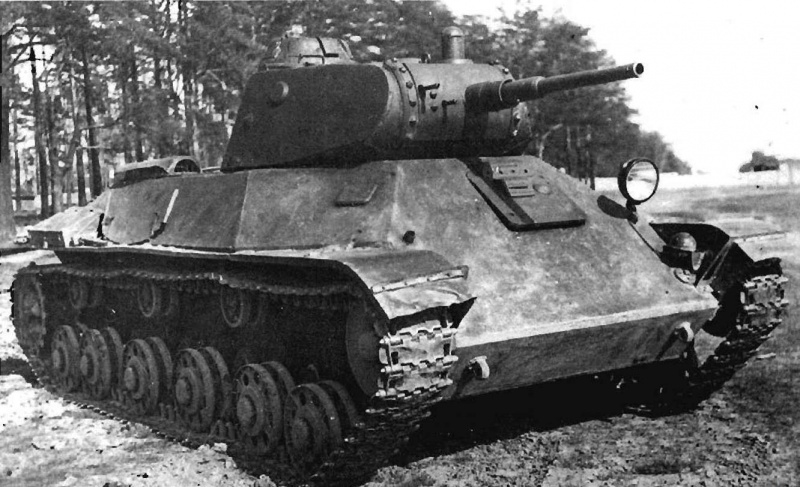







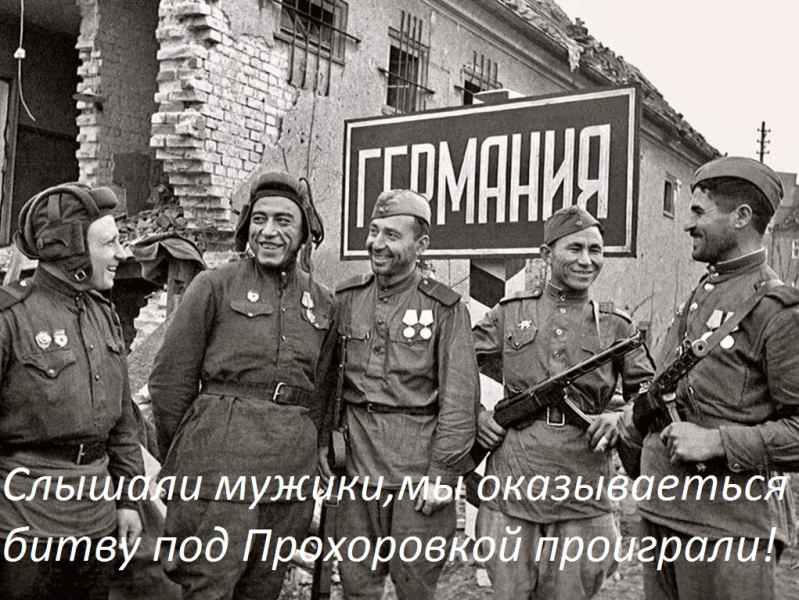




Mystic T-50 – released 50 tanks …
armor 37 mm, N37 factory has not coped with the release of the tank …